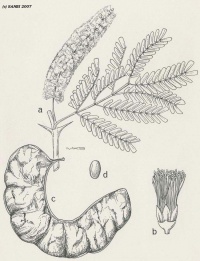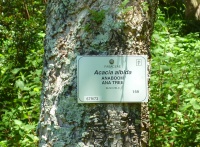Acacia albida (Faidherbia albida)
Contents
General Plant Info
Sacred tree in Judaism, known as 'Anna Tree' or Winter Thorn.
Distribution
Middle-east: Israel, Lebanon, Jordan and Yemen.
Africa: from Senegal to Ethiopia, and southwards through East Africa to the Transvaal and Lesotho, most common in Sudan.
Identification
Bark: Characteristically dull brown to whitish grey, smooth when young, more fissured and flaky and more cork-like in older specimens. The slash is fibrous, pink to light brown (Wood 1992: 9).
Spines: Paired, stipular in origin, moderately thick and straight, up to 1.5-2.3 cm long, frequently directed slightly downwards, white to grey with brown base, base rarely slightly enlarged; spines crowded on new growth, fine and frequently tinged with orange or light brown at the tips, absent or vestigial on old growth; no prickles present (Wickens 1969: 182). They may be distinguished from those of Acacia species with long thorns, such as A. tortilis subsp raddiana, A. nilotica, or A. seyal, by their basal thickening (Wood 1992: 10).
Leaves: Compound and bipinnate with leaflets borne along the pinnae. They are highly variable: the petiole varies from 0.5-3.7 cm long. The rachis is 3-7.5 cm long and carries 2-12 pairs of pinnae, each of which is 2.5-5.5 cm long (Wood 1992: 9-10).
Leaflets: Grey-blue-green, 4-23 pairs per pinna (varies by region) (Wickens 1969: 182).
Flowers: The flowers are borne in dense axillary panicles 3.5-16 cm long, with a peduncle 2-4 cm long. They appear about 2 months after the tree comes into leaf and are sessile or with a pedicel of up to 2 mm. In color they are successively white, cream, and then yellow, and are strongly perfumed (Wood 1992: 10). Flowering commences towards the seventh year (Nongonierma 1976; McGahuey 1985).
Seed pods: Indehiscent pod varying from bright orange to reddish brown and 7-9 mm thick, 6-35 cm long, and 1.4-6 cm wide. It falls from the tree about 3 months after flowering. The pod surface is convex on one side and becomes concave on the other, and as the fleshy mesocarp lignifies, it tends to roll into a spiral resembling dried apple peel, hence the common name "Apple Ring Acacia". There is much variation in pod shape both within and between trees (Wood 1992: 10).
Seeds: Each pod contains 10-29 dark brown shiny seeds, separated by thin septa. They are ovoid, 10 x 6 mm in size and are characterized by an elliptic areolus or hilum measuring about 8 x 5 mm. The seed coat is tough, waterproof, and leathery, and maintains seed viability for many years (Wood 1992: 10).
Alkaloid content
Reported by several sources in Israel to contain DMT in leaves and bark, including official channels.
Other uses
Cattle fodder, nitrogen fixation, silverculture.
Medicinal: Bark used for stomach disorders. Leaves used for colds and ophthalmia (Watt and Breyer-Brandwijk 1962; Hutchings et al. 1996).
Extraction teks
Cultivation / Growing conditions
Suited to sandy alluvial soils, hot climates.
Suppliers
Links
References
Hutchings, A., Scott, A.H., Lewis, G. & Cunningham, A.B. 1996, Zulu Medicinal Plants: An Inventory, University of Natal Press, Pietermaritzburg.
McGahuey, M. 1985, Impact of forestry initiatives in the Sahel on production of food, fodder and wood, Chemonics International, Washington, D.C.
Nongonierma, A. 1976, "Contribution a l'etude bio-systematique du genre Acacia Miller en Afrique occidentale. II. Caracteres des inflorescences et des fleurs.", Bulletin IFAN, vol. 38, pp. 487-642.
Watt, J.M. & Breyer-Brandwijk, M.G. 1932, The Medicinal and Poisonous Plants of Southern Africa: Being an account of their medicinal uses, chemical composition, pharmacological effects and toxicology in man and animal, E. & S. Livingstone, Edinburgh.
Wickens, G. 1969, "A Study of Acacia albida Del. (Mimosoïdeae)", Kew Bulletin, vol. 23, no. 2, pp. 181-202.
Wood, P.J. 1992, "The botany and distribution of Faidherbia albida." in Faidherbia albida in the West African semi-arid tropids: proceedings of a workshop, 22-26 Apr 1991, Niamey, Niger, ed. R. Vandenbeldt, International Crops Research Institute for the Semi-Arid Topics, Patancheru, India, pp. 9-17.

